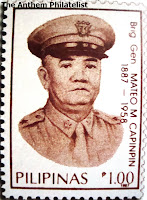Mateo Capinpin on Stamps

A born soldier Gen. Mateo M. Capinpin was already a member of the Boy's Battalion organization at age ten. As a professional soldier, he belonged to the Company "I" of the 4th Infantry, the Pride of Fort Mckinley (now known as Fort Bonifacio). He commanded the 21st division of the U.S. Armed Forces in the Far East (USAFFE) and received the general's star even before the start of World War II.
Brig. Gen. Capinpin, a war time commander of the Philippine Army's famed 21st Division, was born in Morong Rizal on April 22, 1887. He grew up and took his elementary & secondary education in Laguna High School. After graduating from High School in 1906, at the age of 19, he joined and was enlisted in the Philippine Scouts where he started as a Private and was honorably discharged as a Major. During his itinerary with the Philippine Scouts from 1906 to 1918, Capinpin was acclaimed to be the only one who knew his Company Roster by heart. Stories have it that at night, he could call from the roll even without lights. As the youngest First Sergeant, he was only 24 when he was given his strips. He was noted to be a strict disciplinarian and that he had the reputation of being the "meanest" non-commissioned officer.
From the Philippine Scouts, Capinpin joined the Philippine National Guards as First Lieutenant in 1918 with the corresponding rank of Major in the United States Army. The following year, he returned to the Philippine Scouts. Promoted in the Permanent rank of Captain in 1920, Gen. Capinpin was sent to the United States to attend the Officers Courses at Fort Benning Infantry School in Georgia. While a Captain in the 45th Infantry, PS, he commanded the same company for over 20 years. His Company "I" was famous as Exhibition and Demonstration Company for five years in carnivals and elsewhere and held championship for athletics for a longer period.
He was given command of the PA 21st Division with the rank of Colonel when the Philippines was under the Commonwealth regime in 1934. War caught up with him in Lingayen, Pangasinan.
Forced to be in Bataan when the Japanese Forces invaded the country, Capinpin earned honors for the orderly retreat he conducted during his commands trip from Pangasinan to Bataan.
He was captured by the Japanese when Bataan fell. Undaunted, Capinpin forcibly joined the Bataan "DEATH MARCH" which began at daylight of April 10, 1942. Together with the haggard and terrified troops, they herded into groups of 500 to 1,000. Thousands wept while others stood stiffly, with blank, rigid stares. About 12,000 American soldiers, 65,000 Filipino soldiers, 6,000 Filipino civilian employees, and 10,000 Filipino refugees forced to join the trek. More than 600 Americans and 8,000 Filipino soldiers died along the way. On the 65-mile trek from Marivelez, Bataan, Capinpin and others were bayoneted, beaten and hauled off to Camp O'Donnell, a concentration Camp in Capas, Tarlac where the prisoners of war were confined. Documented stories of their confinement described their ordeal as "grim" and "nightmarish." Released in the latter part of 1942, Capinpin briefly served in the puppet government upon the invitation of Jose P. Laurel, the occupation president.
During his service with the puppet government, Capinpin saw in his position a strong cover for his guerilla activities. He planned out to rejoin the underground when he and other officials were dispatched to Baguio. The end of the last war found him in Japan.
Among the commendations he received, topped by the distinguished Service Cross, were telegraphed praises from General Douglas Mac Arthur, then commander-in-chief of all U.S Armed Forces in the Far East, Colonel Clark and the late General Vicente Lim.
Brig. Gen. Capinpin was the Armed Forces of the Philippines Adjutant General when he retired from the military service on April 30, 1948. He was then the Superintendent of the Far East Military Academy in Highway 54, Quezon City. His last public appearance was on December 16, 1958 during the convocation at the FEMA. At the age of 71, on December 28, 1958, he died of heart attack while spending holidays at his residence in Binan, Laguna.
Brigadier General Capinpin was survived by his wife, Mrs. Trinidad F. Vda. de Capinpin, and three children; Emmanuel, Ernesto and Alita.
The Stamp was issued on October 15, 1987.





